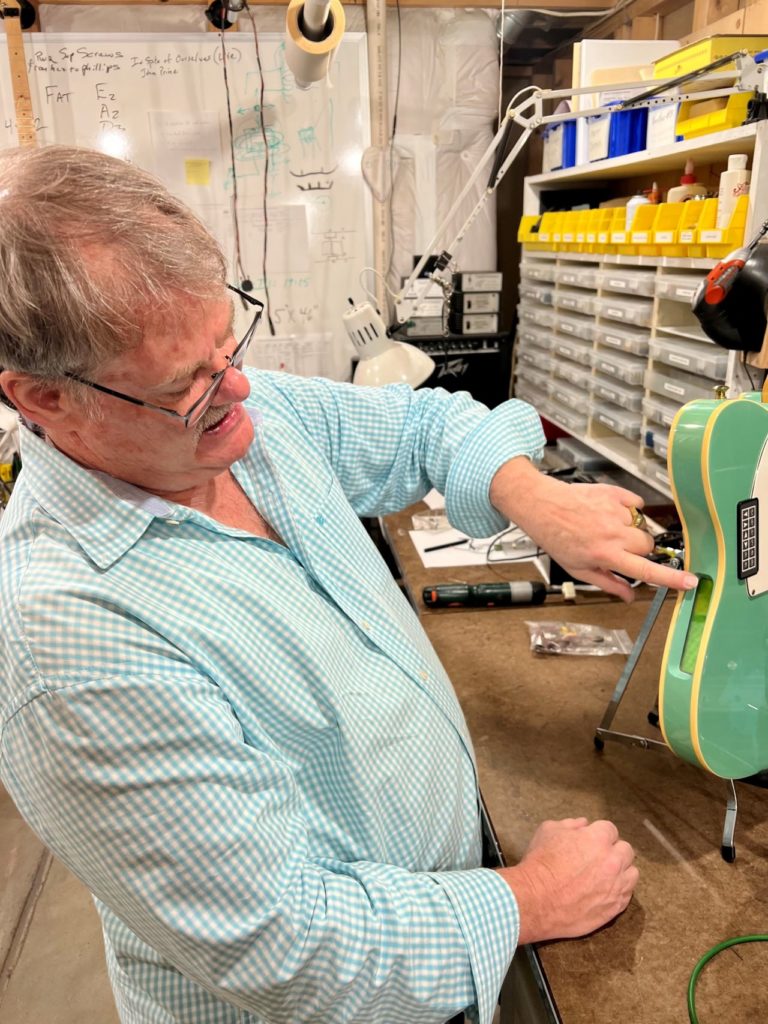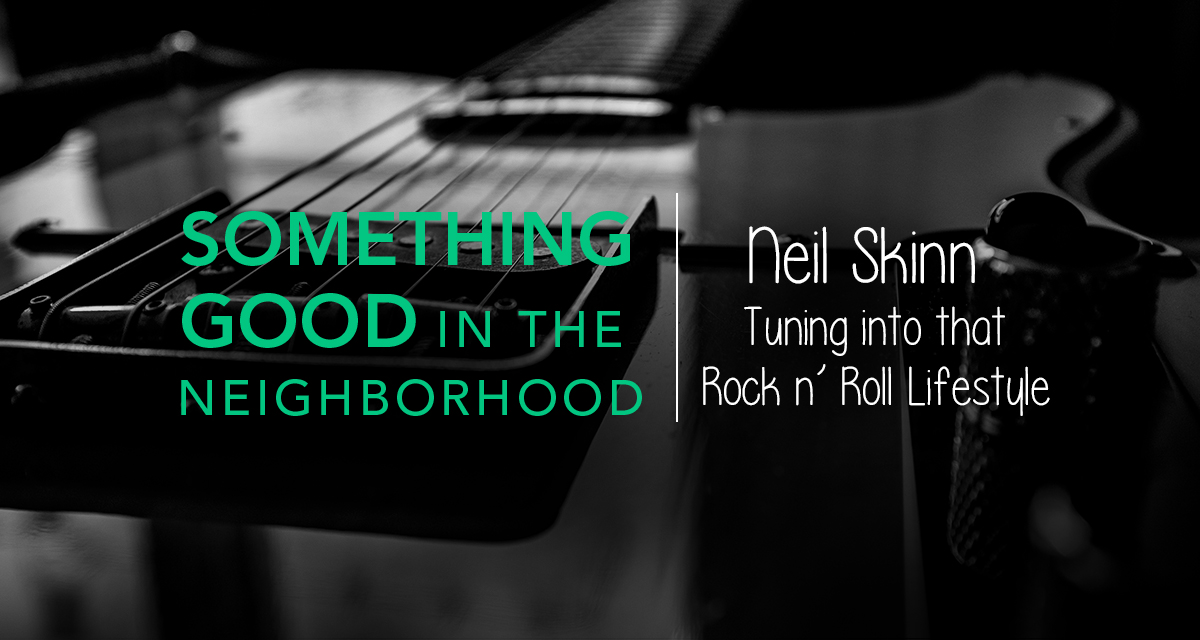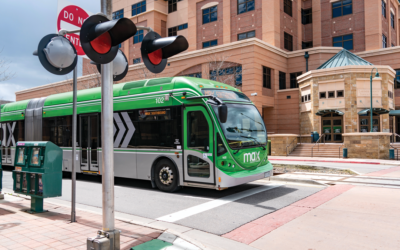Neil Skinn knows how to tell stories. He has a million, each full of rock stars and their shenanigans, even a few his own band slipped into during the glory years. So, he knows you’re supposed to save the best part for last.
But Neil, known as “Skinn” in the music industry, can’t help himself. This is why, even though you just met him, he pulls out the Jimmy Page anthology book and turns it to the page that mentions his name.
Yes, THE Jimmy Page, the legendary guitarist from Led Zeppelin. Yes, Skinn skipped to the best part, but can you blame him?
Skinn then launches into the moment back in the late ‘80s when he first heard from Page. It was 4 a.m. when Skinn’s phone rang. Skinn, sleepy, answered the phone. “Hello,” Page says in his British accent. “This is Jimmy Page.”
Skinn launched himself out of bed and tried to shake off the sleep while Page told him he’d just watched the videotape Skinn sent him describing his invention. It was brilliant, he says. Is it real?
The book backs up his story, but so does his basement, where he keeps the book, all his equipment and parts, and a line of guitars that show the progression of his invention. His claim to fame: Skinn, 66, invented a self-tuning guitar. Essentially, at the push of a button on the guitar fitted with a contraption, it can tune itself in seconds from thousands of settings. “Pure genius,” Page says in the book.
Skinn’s story includes flying out to meet him, and Page telling Skinn, after he became Skinn’s first customer and bought his self-tuner for $10,000, that he couldn’t sell one to Joe Perry of Aerosmith. Perry called him a few weeks later (and did, in fact, eventually buy one).
There are many other stories, of his friendship with Les Paul and talking to Eddie Van Halen in his garage in the middle of the night and how he worked on computers with 10-megabyte hard drives (as you know, now they measure a simple smartphone in gigabytes). He has his own display in the Discovery Museum of Fort Collins, one that will expand once he delivers his old computers and other equipment he used to develop the guitar.
B ut the basement is not in a mansion. His house is nice, but it’s simple, in a pleasant Fort Collins neighborhood. He’s lived there for years, and yet, he’s still paying it off. He didn’t, in a nutshell, get rich off the invention.
ut the basement is not in a mansion. His house is nice, but it’s simple, in a pleasant Fort Collins neighborhood. He’s lived there for years, and yet, he’s still paying it off. He didn’t, in a nutshell, get rich off the invention.
He would have made a better living had he used his expansive smarts to work an engineering job, he says today. He may have had a better life, too, or at least a more relaxing one. He could have watched TV instead of spent so many hours in his basement. He could have paid off his house. He could have sent his kids to college.
“It ruined my life,” he says, and he laughs because he’s joking, only the laugh fades because, well, not entirely.
Inspiration
Electrical tuners that tell you the pitch have made it a little easier, but it’s still a pain to tune a guitar, and it takes time. This is how Skinn got the idea for a self-tuning guitar back in the mid-80s, when he was jamming with buddies and one of his friends wrestling with the strings says, “Man, I wish these things tuned themselves.”
A few years later, Skinn realized it was possible by using math to read a vibrating string. The math could essentially assign a specific tuning with a calculation that Skinn could program. The program would direct motors in the guitar to tune the six strings in seconds.
This description, by the way, is simplified and quite possibly partially inaccurate, but you get the gist. The method is so complex that Skinn may be the only person alive who completely understands his system. He’s trying to teach his children and grandchildren how it all works, but “they complain a lot when it gets too intense.” (Editor’s note: Kids, we get it).
Skinn wasn’t born a genius, but he became one through the GI Bill. He was a Vietnam veteran, so he attended classes at Colorado State. He took chemistry, math, computers, engineering and mechanics classes. This was by design: He wanted more smarts than what one degree could give him.
“I never got the degree,” he says, “but I got the knowledge.”
Skinn would need all of it to make his idea happen, and he relied on a team of mechanics and engineers, including his brother, Fred, for help. He points this out many times, as he’s proud of his work but didn’t do it alone. He even had to write his own computer language to make it work.
“Some of the problems were so damn intense,” he says.
Still, Skinn found a way by relying on inspiration when it struck: He figured out part of the mechanics by copying oil derricks he saw on the way to a Broncos game. When his patent was approved, he founded TransPerformance—it’s now AxCent Tuning Systems—in 1987. Two years later, Page called him after Skinn spent most of that time trying to reach him. Page was known as the master of alternate tunings, making him a natural candidate for Skinn’s system. Page sent him plane tickets to meet him in Reno, Nevada.
“I thought I was on top of the world,” Skinn says. “He treated me like gold.”
Page purchased the system then and used it to record an album with David Coverdale, former frontman for Deep Purple and the lead singer of Whitesnake, back in 1990. He’s played it ever since and owns several guitars installed with it. He even worked with Skinn for two years to improve the system.
The fun started after that, with Perry’s phone call and his friendship with Les Paul. Skinn raised $5 million dollars to develop a marketable system, and other artists used it religiously, including Kenny Loggins, Peter Frampton and, yes, Eddie VanHalen. Skinn also played in a rock band for 10 years, from 1988-98, opening for many prestigious acts because of his invention. He and his wife, Vickie, went to every concert, and he’d approach guys with walkie talkies in parking lots and show off his guitar, usually landing him backstage, where he’d meet the artist and sometimes make another sale.
The problem was that those sales ended with the big boys. His system was expensive: It cost thousands to install one into a guitar. Most guitar players couldn’t afford one. They were lucky to afford their next meal. Even the bigger guitar players who were making a good living but weren’t superstars wanted “comp” or free systems installed for an endorsement. Skinn had to refuse: He couldn’t give away his product.
“It took me 30 years to figure out a guitar player couldn’t afford a $3,000 accessory,” Skinn says.
Skinn worked hard for years to try to get the costs down, but by the time he developed a system for a few hundred you could tune with your phone, it was too late. Skinn wasn’t broke: He paid himself a fair wage out of the investment money, but his investors never recouped a cent. When other guitar brands developed their own system but essentially failed, it muddled the market. Skinn still believes his system is superior: It’s the only one that tunes in seconds, allowing guitarists to use it while they play, and it’s by far the most reliable. It can tune to 80,000 nameable tunings at the press of a button, he says, and each system is customized.
Skinn still has enough to install the system for guitarists who want one, and he still services his 400 systems out on the market, many for elite or famous players. He still works hard, but it’s not full-time: He manages gold mines in Alaska to pay his mortgage.
There’s a lot more to this story, and Skinn could keep you here for days talking about it. His pride comes with mixed emotions, as he’s “fighting the devil just to pay for his house and food.”
“But I’m prouder of this than any man is proud of anything,” Skinn says. “After I’m dead, self-tuning WILL happen one day, and I’ll be the person who pioneered it.”
He wound up in the pages of Led Zeppelin’s history book. Not many others can say that, he says. And he still has Jimmy Page’s cell phone number.
Here are two historically huge concerts where Jimmy Page used Neil’s guitar.
“Whole Lotta Love” this clip is from Led Zeppelin’s Reunion Concert in 2007. Approximately 20 million people tried to buy tickets to this show. Only 17,000 were available. Considered the most sought after concert ticket in history.
“Kashmir” from the Jimmy Page and Robert Plant concert and video “No Quarter” filmed in 1994
_____________________________________________________________
Dan England is NOCO Style’s assistant editor and a freelance journalist based in Greeley.








